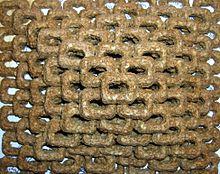Cracklin' Oat Bran is a breakfast cereal made by Kellogg's and introduced in 1977.[1] The cereal is made of oat bran flavored with cinnamon and nutmeg and is held together by brown sugar in a rectangular shape. The cereal is a source of dietary fiber as its first two ingredients are whole oats and sugar, but it contains a significant amount of saturated fat. The palm oil used in the cereal is modified slightly to suggest more of a sugary flavor than normal palm oil.
The recipe for Cracklin' Oat Bran underwent a major change in 1989, when consumer health advocates pushed for Kellogg's to remove coconut oil, which is 92% saturated fat, from the cereal.[2] A second recipe alteration occurred in the late 2010s after Kellogg changed the source of its toasted bran ingredient and removed artificial colors and flavors from the product. The change prompted complaints and petitions calling for a return to the previous recipe.
One serving of Cracklin' Oat Bran (without milk) contains 34 grams of carbohydrates, 14 grams of sugar, 6 grams of dietary fiber, 4.4 grams of protein, 3.4 grams of saturated fat, 0.1 grams of trans fat, and 200 calories.
References
- ^ Kellogg Company History
- ^ Agnew, Joseph T (April 1989). "The controversy over tropical oils". The Rotarian. Rotary International. 154 (4): 10. ISSN 0035-838X.
External links
- Cracklin' Oat Bran page on Kellogg's Web site
- Nutritional information
- Time article about removal of coconut oil in 1989.
